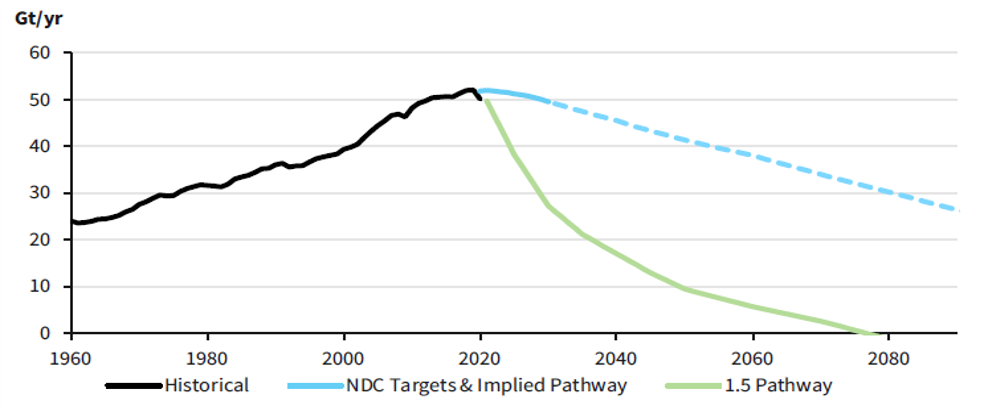The 27th Conference of the Parties (COP) to the United Nations Framework Convention on Climate Change was held from November 6th to 18th in Sharm el-Sheikh (Egypt). After the hopes and determination shown in 2021 at the COP 26 in Glasgow, progress is very slim in a very uncertain global geopolitical context. Faced with increasingly hypothetical greenhouse gas emission reduction targets, progress is to be sought in climate change adaptation policies, especially for countries which are most vulnerable to physical risks. However, beyond the short-term constraints linked to the Russian-Ukrainian conflict and its consequences on fossil fuel supplies (coal and liquefied natural gas in particular), the conditions have never been so favorable for accelerating investments in renewable energies and clean technologies.
Behind too timid progress ...
The COP 27 was held in November in a context of global energy crisis unseen for more than 50 years. Despite a strong will to follow the line of previous COPs and to reaffirm the commitment to the objective of limiting the rise in temperature to a level well below 2°C and if possible to 1.5°C, it is clear that the actions do not follow the ambition.
Let's recall that in 2021 in Glasgow, all countries had agreed to revise their ambitions upwards by updating their targets (through their "National Determined Commitments" (NDC)). In November 2022, only 26 of the 194 signatories have actually submitted their revised contributions, of which only Australia, Mexico, Norway, Turkey and Thailand represent significant economic weight (i.e., only about 5% of global GHG emissions).
All the current commitments would lead to a 1% decrease in GHG emissions by 2030 (compared to 2019), whereas the objective of 1.5°C of global warming would require a 43% decrease (i.e., an average annual decrease of 7% between 2022 and 2030).

Source: Climate Action Tracker
Between the collective inability to align commitments with a 1.5°C or 2°C trajectory and the increasing frequency and intensity of extreme weather events (drought and giant fires in Europe and North America, floods of unprecedented magnitude in Pakistan, etc.), the attention of participants at COP 27 in Sharm el-Sheikh was focused more on the adaptation component. This resulted in the launch of a series of initiatives to improve the resilience of communities and countries most at risk from the physical consequences of global warming, including:
- The "Loss and Damage Facility", a fund that will be financed by developed countries to compensate for the loss and damage suffered by countries which are most vulnerable to the effects of climate change.
- The "Energy Transition Accelerator", a carbon offset mechanism proposed by John Kerry (US Special Envoy for Climate Change) and intended to incentivize the private sector to buy carbon credits in the countries where companies operate in order to help finance the energy transition of these countries.
- The "Global Shield against climate change", an initiative announced at the G7 meeting in June 2022 and a forerunner of the above-mentioned Loss and Damage Facility, aimed at supporting the V20 countries ("The Vulnerable Twenty", an initiative launched in 2015 and now comprising 58 of the most vulnerable countries to climate change). Germany has announced an initial contribution of $170 million, supplemented by $40 million from other countries. The first beneficiaries should be Bangladesh, Costa Rica, Pakistan and Senegal.
These announcements and the collective awareness of the importance of adaptation policies have saved the outcome of COP 27, although most of the implementation modalities have been postponed and the financial means committed seem very low in relation to the scale of the challenge.
... the forces behind the ecological transition have never been so strong
However, as destabilizing as the current geopolitical situation and its consequences on the global energy ecosystem may be, we are entering a phase of favorable alignment of the determinants of the ecological transition in the medium and long term:
- A generalized awareness of the effects of global warming and its economic and financial consequences (multiplication of extreme events causing business interruptions, threat to agricultural yields, water shortages...), and therefore the need to limit its impacts.
- An economic equation that is now favorable to the production of renewable energies, with a production cost half that of fossil fuels. The cost of a megawatt-hour of renewable energy is around $45 (for onshore wind and solar) compared to $74 for coal and $81 for gas.
- A new geopolitical situation leading to a reconfiguration of energy supply chains, with security and independence as key words.
In this context, investments in renewable energies and more broadly in clean technologies should accelerate, as energy security and independence become the best allies of the ecological transition.
As a reminder, green investments accounted for just over $800 billion in 2019 worldwide, still far from the $4 trillion to $5 trillion needed each year to reach the goal of limiting global warming to 1.5°C by 2100.



